
Dzogchen, also known as atiyoga, is a tradition of teachings in Indo-Tibetan Buddhism and Yungdrung Bon aimed at discovering and continuing in the ultimate ground of existence. The primordial ground is said to have the qualities of purity, spontaneity and compassion. The goal of Dzogchen is knowledge of this basis, this knowledge is called rigpa. There are numerous spiritual practices taught in the various Dzogchen systems for awakening rigpa.
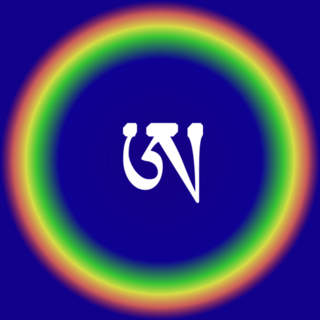
In Dzogchen, rigpa is knowledge of the ground. The opposite of rigpa is ma rigpa. A practitioner who has attained the state of rigpa and is able to rest there continuously is called a Rigdzin or Rigma, which may be used as a title either pre- or post-nominally.
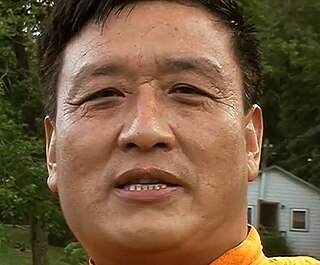
Tenzin Wangyal Rinpoche is a teacher (lama) of the Bon Tibetan religious tradition. He is founder and director of the Ligmincha Institute and several centers named Chamma Ling, organizations dedicated to the study and practice of the teachings of the Bon tradition.

Tashi Paljor, Dilgo Khyentse Rinpoche was a Vajrayana master, scholar, poet, teacher, and recognized by Buddhists as one of the greatest realized masters. Head of the Nyingma school of Tibetan Buddhism from 1988 to 1991, he is also considered an eminent proponent of the Rime tradition.
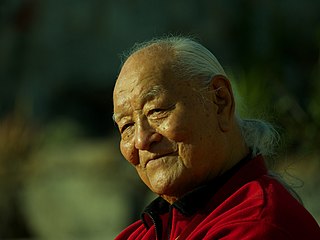
Namkhai Norbu was a Tibetan Buddhist master of Dzogchen and a professor of Tibetan and Mongolian language and literature at Naples Eastern University. He was a leading authority on Tibetan culture, particularly in the fields of history, literature, traditional religions, and Traditional Tibetan medicine, having written numerous books and scholarly articles on these subjects.

Trul khor, in full tsa lung trul khor, also known as yantra yoga, is a Vajrayana discipline which includes pranayama and body postures (asanas). From the perspective of the Indo-Tibetan Buddhist traditions of Dzogchen, the mind is merely vāyu in the body. Thus working with vāyu and the body is paramount, while meditation, on the other hand, is considered contrived and conceptual.

Lukhang, formally Dzongyab Lukhang, residence of Nagas, lords of the castle and administered territory [?]) is the name of a secret temple of Lozang Gyatso, 5th Dalai Lama. Three walls of the temple are covered with murals of yogis engaged in their exercises.

Ayu Khandro, also known as Dorje Paldrön, was a Tibetan yogini, practitioner and terton of Tantric Buddhism in Eastern Tibet. An accomplished Dzogchen meditator, she is known for her extensive pilgrimages throughout Tibet, long periods of dark retreat practice, the gongter of the practice of the yidam Senge Dongma, various forms of Chöd, and her lifelong dedication to spiritual practice.
Semde (Tibetan: སེམས་སྡེ, Wylie: sems sde; Sanskrit: cittavarga, "mind division", "mind class" or "mind series" is the name of one of three scriptural and lineage divisions within the Dzogchen tradition. The Nyingma school of Tibetan Buddhism traditionally classifies its Dzogchen teaching into three main divisions: Semde, Longdé and Menngagde.
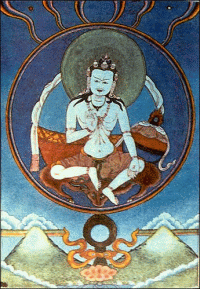
Garab Dorje was the first human to receive the complete direct transmission teachings of Sutra, Tantra and Dzogchen from Vajrasattva. The circumstances of his birth are shrouded in different interpretations, with some accounts describing a miraculous birth by a virgin daughter of the king of Uddiyana.
Reality in Buddhism is called dharma (Sanskrit) or dhamma (Pali). This word, which is foundational to the conceptual frameworks of the Indian religions, refers in Buddhism to the system of natural laws which constitute the natural order of things. Dharma is therefore reality as-it-is (yatha-bhuta). The teaching of Gautama Buddha constitutes a method by which people can come out of their condition of suffering through developing an awareness of reality. Buddhism thus seeks to address any disparity between a person's view of reality and the actual state of things. This is called developing Right or Correct View. Seeing reality as-it-is is thus an essential prerequisite to mental health and well-being according to Buddha's teaching.
Nyala Pema Dündul (1816–1872), also known as Terton Nyala Pema Duddul, was a teacher of Dzogchen and Tantric Buddhism in Eastern Tibet.
In Tibetan Buddhism and Bon, Menngagde, is the name of one of three scriptural and lineage divisions within Dzogchen.
Svabhava literally means "own-being" or "own-becoming". It is the intrinsic nature, essential nature or essence of beings.
Getse Mahapandita (1761–1829) was an important Nyingma scholar affiliated with Kathok Monastery.

In Dzogchen, the ground or base is the primordial state. It is an essential component of the Dzogchen tradition for both the Bon tradition and the Nyingma school of Tibetan Buddhism. Knowledge of this ground is called rigpa.

Nyoshül Khenpo Rinpoche, more fully Nyoshül Khenpo Jamyang Dorje, was a Tibetan lama born in the Derge region of Kham.

In Dzogchen, trekchö means "(spontaneous) cutting of tension" or "cutting through solidity." The practice of trekchö reflects the earliest developments of Dzogchen, with its admonition against practice. In this practice one first identifies, and then sustains recognition of, one's own innately pure, empty awareness. The main trekchö instructions in the Lamrim Yeshe Nyingpo state "This instant freshness, unspoiled by the thoughts of the three times; You directly see in actuality by letting be in naturalness."
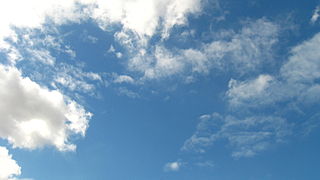
In Dzogchen, the view is one of the Three Dharmas of the Path of Dzogchen. The other two dharmas of the path are practice (gompa) and conduct (chöpa).

Dzogchen, also known as atiyoga, is a tradition of teachings in Indo-Tibetan Buddhism aimed at discovering and continuing in the ultimate ground of existence. The primordial ground is said to have the qualities of purity, spontaneity and compassion. The goal of Dzogchen is knowledge of this basis, this knowledge is called rigpa. There are numerous spiritual practices taught in the various Dzogchen systems for recognizing rigpa.














